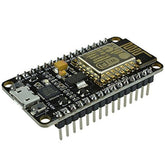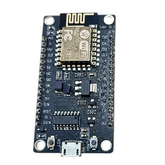What is NodeMCU ESP8266: Complete Guide
Summary
Do you want to learn more about the NodeMCU ESP8266, a small yet powerful Wi-Fi microcontroller board?
If the answer is Yes! Then check out our comprehensive tutorial, which covers everything from board setup to programming; we provide all-inclusive information suitable for all skill levels.
Whether you're a seasoned developer or a pro, our blog is a valuable source to unleash the potential of this impressive microcontroller. Get ready to be astonished by ESP8266's capabilities!
What is NodeMCU ESP8266?
NodeMCU is an open-source firmware, hardware, and software development environment project developed initially for the ESP8266 Wi-fi SoC chip based on LUA. The most spectacular features are:
It is a low-cost, small, and powerful board. It is specifically designed for IoT applications. It is compatible with Arduino IDE and Python, making prototyping a lot faster.
Because of all these features, Node MCU ESP8266 is the most popular and trending board in the electronics market.
The below images show NodeMCU development board v0.9 and v1.0 (right).

The v0.9 board is also called as 1st generation or V1 board. It is very wide and not convenient to use on a breadboard. This limitation is overcome by its next generation, i.e. 2nd generation or v1.0 or V2 board.
This ESP8266 NodeMCU WiFi development board is narrower and easier to fit on the breadboard. Also, the chip in this board is upgraded, i.e. from ESP-12 to ESP-12E.
3rd generation board V3 is produced by LoLin, which has minor improvements over the V2 board and is believed to have a more robust USB port than its predecessor(CH340G USB-TTL chip is used instead of Silabs CP2102 from V1.0). But again, this board is wide, making it difficult to use.
Since it can be connected to the Internet, it can be used in a wide variety of applications like smart houses, smart industrial devices, smart healthcare devices, etc.
Read our blog post esp8266 vs Arduino, which compares the features of Arduino UNO and NodeMCU.
Nodemcu ESP8266 Specifications & Features:
- The onboard ESP8266 chip manufactured by Espressif Systems has an ESP8266EX core Wi-Fi SoC and a Tensilica L106 32-bit processor in the same chip.
- Node MCU ESP8266 has 2.4GHz 802.11b/g/n Wi-fi with on-board antenna, which supports WPA/WPA2.
- It has 17 GPIO, 11 are usable( 6 are used for communication with the onboard flash memory chip), and some of them support PWM. This GPIO can be used to interface the ESP8266 NodeMCU with the external environment through sensors and actuators.
- It also has UART, SDIO, SPI, I2C, I2S, and an IR remote control peripheral interface.
- It operates on 2.5- 3.6V and averages 80mA current with temperatures ranging from -40° to 125°C.

- It comes in a QFN 32-pin ( 5mm * 5mm) package.
- It supports firmware upgrades via UART download/ OTA (via network).
- It also has an SDK for customized development/cloud server development.
NodeMCU ESP8266 Pin Diagram.

Pins from D0-D8 can be used as GPIO pins.
Let's discuss the ESP8266 NodeMCU pin configuration in detail.
UART pins:
GPIO1 and GPIO3 are TX and RX pins, respectively, used for UART communication.
I2C pins:
D1 and D2 can be used for SCL and SDA for I2C communication.
Note that NodeMCU doesn't have hardware I2C pins. We can implement I2C in software on any GPIO pins.
SPI pins:
D5-D8 ( SCLK, MISO, MOSI, AND CS ) can be used for SPI communication.
You can see that in the above pinout diagram, we have not labelled pins from GPIO6 to GPIO11. The reason they are not shown is that they cannot be used for interfacing because they are connected ot the flash chip.
Analog Pin:
The pin marked as A0 on the silkscreen layer of the PCB is the only pin that can analog read.
ESP8266 On-board LED:
The onboard LED is connected to GPIO2.
Reset pin:
You can reset the ESP8266 NodeMCU board in 2 ways: one is by pressing the reset button, and the other is by pulling the reset pin LOW.

Reference: Espressif
The block diagram of ESP8266EX is shown in Figure 5, which explains the architecture of the chip.
How to Program NodeMCU ESP8266 with Arduino IDE?
The following are the steps to upload the program to the NodeMCU ESP8266:
1. Install the ESP8266 by the ESP8266 Community
Open Arduino IDE. Go to File> Preferences


The above two URLs in additional board manager URLs.
These URLs allow us to add additional boards in Arduino IDE. ( above URLs add ESP32 and ESP8266 NodeMCU boards.)
Once done, click OK.
Now go to Tools > Board > Boards Manager …

2. Once installation is done upload your program by selecting the board

3. Open the Blink sketch for ESP8266.

4. Select the appropriate COM port and click on upload.
Once uploading is done, you will see the LED blinking on the board!!
Best 5 NodeMCU ESP8266 Project Ideas in 2025
- Simple GPS Tracker and Data Visualization on Map
- Send Messages to WhatsApp
- ESP32-CAM Face Recognition Door Lock System
- WiFi-Controlled Mini Drone
- Door Monitoring System with Email Notifications
Conclusion:
The NodeMCU is a powerful and versatile platform, it bestows upon us mere mortals a realm of endless possibilities for IoT applications and DIY projects.
It has grown in popularity among both amateurs and professionals because to its low cost and ease of use, and it is backed by a large online community. This extensive study has provided you with a detailed understanding of its internal operations and capabilities.
Whether you're a beginner or an experienced electronics user, the ESP8266 is an indispensable tool for your next project. So, what are you waiting for? Discover the full potential of the ESP8266 right now!
If you understand what NodeMCU ESP8266 is and appreciate our work, don't forget to share this post and leave your opinion in the comment box.
Please do check out other blog posts about Popular Electronics
Make sure you check out our wide range of products and collections (we offer some exciting deals!)







